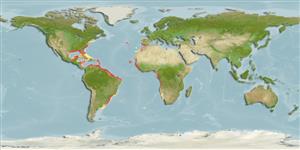Common names from other countries
Environment: milieu / climate zone / depth range / distribution range
Ecologia
marino; salmastro; distribuzione batimetrica 10 - 180 m (Ref. 27121). Subtropical; 44°N - 40°S, 97°W - 16°E
Western Atlantic: New England, USA and Bermuda to Argentina (Ref. 47377). Eastern Atlantic: Mauritania to Namibia (Ref. 27121). Southwest Atlantic: Sergipe, Brazil (Ref. 118626).
Size / Peso / Age
Maturity: Lm ? range ? - ? cm
Max length : 100.0 cm TL maschio/sesso non determinato; (Ref. 3694); common length : 60.0 cm TL maschio/sesso non determinato; (Ref. 3694); peso massimo pubblicato: 4.9 kg (Ref. 40637)
Spine dorsali (totale) : 0; Raggi dorsali molli (totale) : 13 - 15; Spine anali: 0; Raggi anali molli: 12 - 13.
Inhabits inshore and near-shore areas, over sand or mud bottoms. Usually found alone or in small, loose aggregates. Adults are pelagic, but near continental margins; young are commonly found on coastal and offshore banks (Ref. 7251). Feeds on fish and shrimps (Ref. 28587). Minimum depth from Ref. 26912. Its flesh is very delicate; nevertheless, in certain region like the Pacific and the Indian Ocean, it is toxic (particularly the skin and the viscera) (Ref. 5377). Poisonous, should not be eaten (Ref. 36731).
Life cycle and mating behavior
Maturities | Riproduzione | Spawnings | Egg(s) | Fecundities | Larve
Shipp, R.L., 1990. Tetraodontidae. p. 1069-1072. In J.C. Quero, J.C. Hureau, C. Karrer, A. Post and L. Saldanha (eds.) Check-list of the fishes of the eastern tropical Atlantic (CLOFETA). JNICT, Lisbon; SEI, Paris; and UNESCO, Paris. Vol. 2. (Ref. 7464)
IUCN Red List Status (Ref. 130435)
CITES (Ref. 128078)
Not Evaluated
Human uses
Pesca: scarso interesse commerciale
Strumenti
Special reports
Download XML
Fonti Internet
Estimates based on models
Preferred temperature (Ref.
115969): 16.2 - 27.3, mean 23.2 (based on 373 cells).
Phylogenetic diversity index (Ref.
82804): PD
50 = 0.5005 [Uniqueness, from 0.5 = low to 2.0 = high].
Bayesian length-weight: a=0.02042 (0.01592 - 0.02619), b=2.85 (2.81 - 2.89), in cm Total Length, based on LWR estimates for this species (Ref.
93245).
Trophic level (Ref.
69278): 4.0 ±0.69 se; based on food items.
Resilienza (Ref.
120179): Medio, tempo minimo di raddoppiamento della popolazione 1.4 - 4.4 anni (Preliminary K or Fecundity.).
Fishing Vulnerability (Ref.
59153): High vulnerability (60 of 100).
